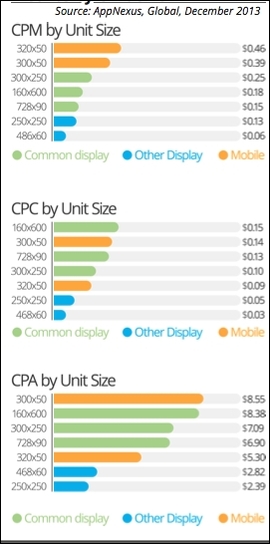In Tuesday’s RTB Insider, Skip Brand overviewed
“programmatic creative,” and how CPXi is touting the method’s ability to help marketers achieve scale.
I would argue that it could be misleading to say it leads to
scale, but that the application of programmatic technologies to the creative process is a logical next step for the industry.
Some background: CPXi is an ad technology company with
a platform that allows marketers to design creative that is automatically adjusted and formatted for numerous digital ad sizes; marketers design one piece of creative and immediately receive it in
multiple sizes. CPXi is also integrated with ad exchanges, so marketers can then apply it to real-time bidding (RTB) campaigns.
Jeff Hirsch, the company’s CMO,
told RTM Daily that because creative costs so much to develop, most marketers only focus on three ad sizes. He hopes that with the use of programmatic creative, marketers will
use more sizes.
“If you have everyone bidding on the same sizes, you create an artificial price that’s potentially above the value of that media,” he reasoned.
“It happens with audience targeting and sizes.”
CPXi used global data from the AppNexus exchange from December 2013 and found than 96% of display impressions are
reserved for the top three unit sizes: Leaderboard (728x90), Medium Rectangle (300x250) and Wide Skyscraper (160x600). Similarly, 92% of campaigns use only those three sizes.
But
Hirsch sees missed opportunity when it comes to not using other sizes, and he doesn’t think expensive creative should hold advertisers back from using them. While that’s a self-serving
thought of his, the figures from AppNexus support his reasoning.
The CPM for 300x250 sized ads was $0.25 on the AppNexus exchange in December 2013. The CPM for the 160x600 size was $0.18, and the
CPM for the 728x90 size was $0.15.
The less-used sizes, such as 250x250 and 486x60, were cheaper. The 250x250 size’s CPM was $0.13, and the 486x60 size was $0.06.
So how does that relate to the cost-per-click (CPC) or cost-per-action (CPA)? Advertisers pay at least twice as much per click for the three major sizes compared to the 250x250 and 486x60
sizes.
“People are bidding on these larger sizes, but they are not performing better,” Hirsch noted.
When it comes to what ad sizes to spend on,
people’s minds won’t be made up after one report. And as one commenter -- Mike Einstein from the Brothers Einstein -- noted at the bottom of yesterday’s RTB Insider: using
more ad sizes doesn’t necessarily mean a marketer has achieved scale.
CPXi claims that over 3.5 billion impressions are left over per month (according to AppNexus data) once
the “Big 3” ad sizes have had their fill. But that’s still a fancy way of saying “less than 5% of the month’s impressions.”
Could an easier way
to create ads for the less-used sizes lead to the "Big 3" taking up less of the pie? Sure, but it’s not going to happen overnight. Plus, expensive creative is not the only reason those three ad
sizes are the most used.
Regardless of the debate over “scale” in this case, I do think this type of technology is good for the market. I might not think it’s
“critical” like Hirsch does, but as I said before, it’s a logical next step.
Why? Because it’s helping marketers use more of what online advertising has to
offer. And it’s doing so in a way -- via automation -- that marketers are getting comfortable with.